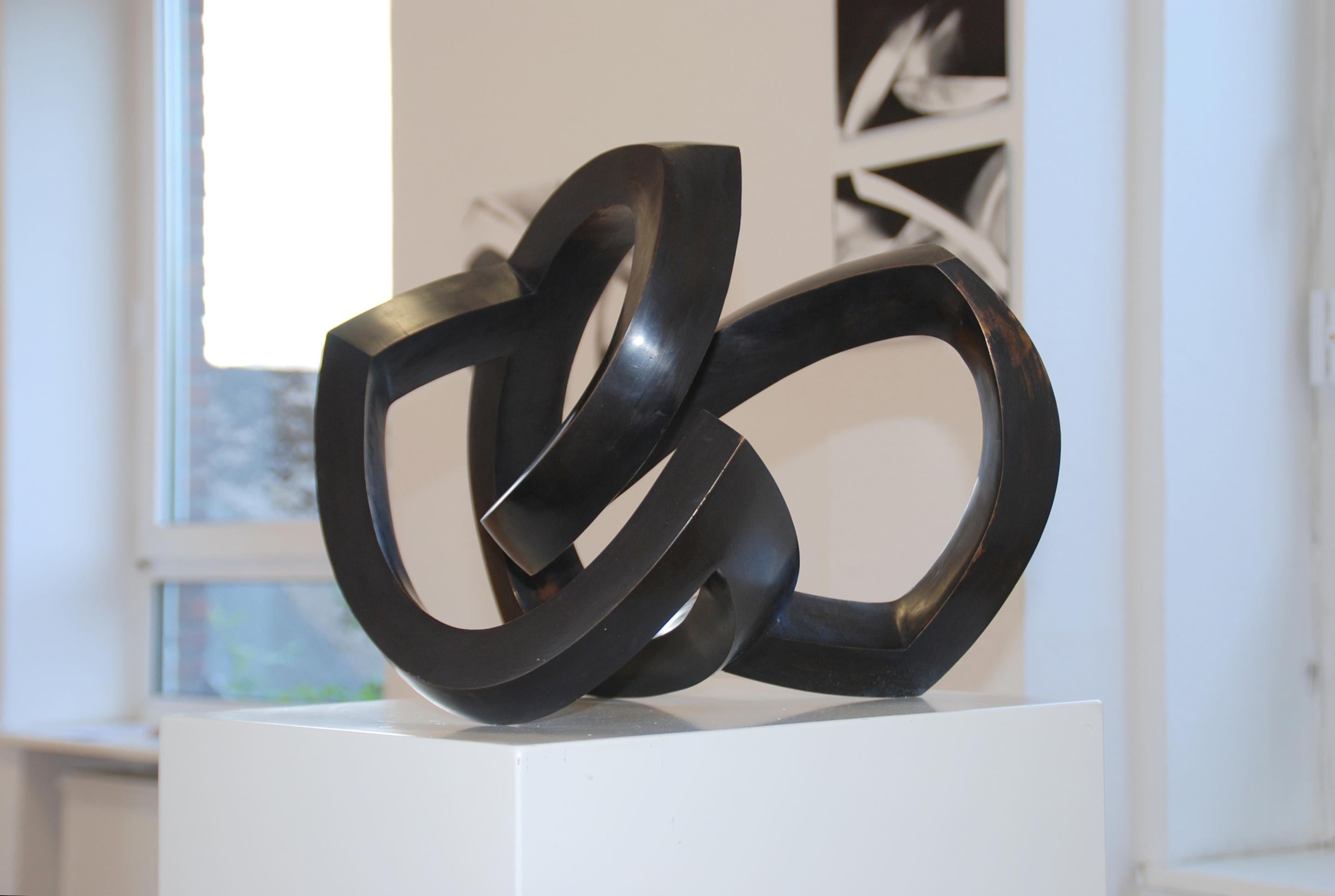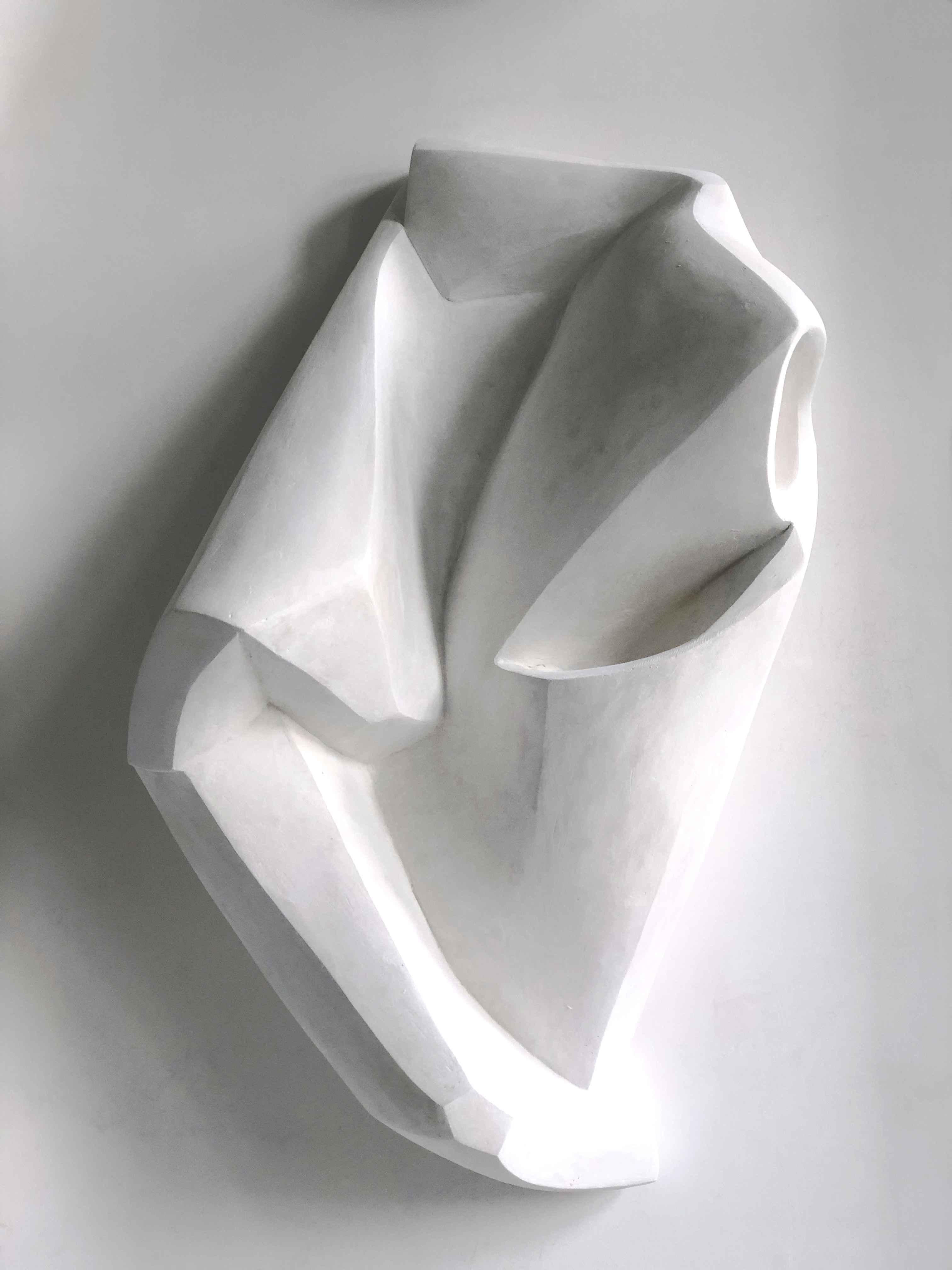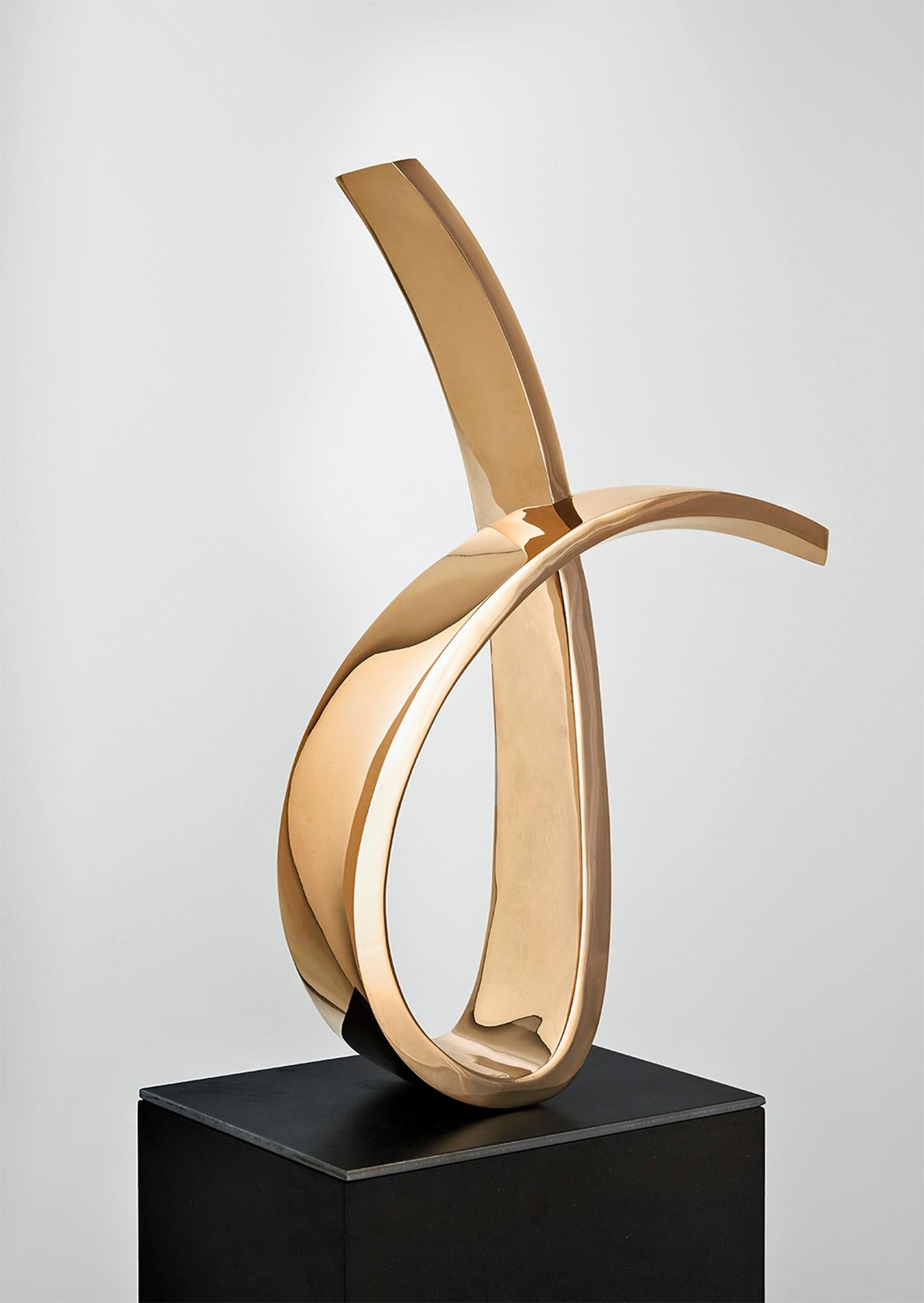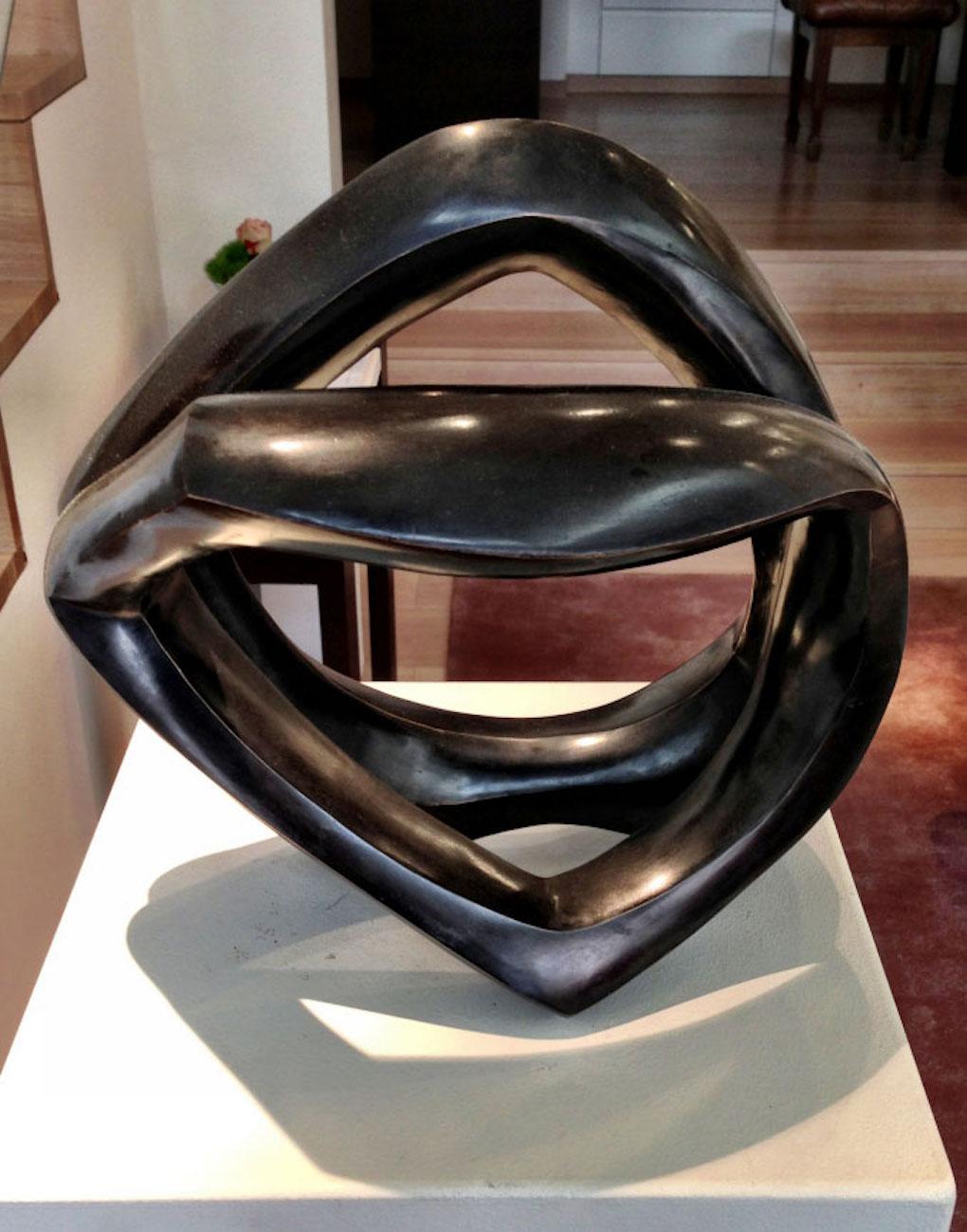Items Similar to Multiply Connected Triangle II
Want more images or videos?
Request additional images or videos from the seller
1 of 5
Colleen WolstenholmeMultiply Connected Triangle II2015
2015
About the Item
By Sophie Lynch
In Hyperobjects, Nova Scotia-based artist Colleen Wolstenholme presents works that developed from her earlier drawings of brain cell patterns and her interest in the way consciousness emerges from physical formations in the brain. While philosophers and scientists have persistently pondered the nature of consciousness, some have questioned whether our most private and qualitative experiences of the world could ever be explained by neural oscillations in the cerebral cortex. Carried by the current of her interest in the puzzling problem of consciousness, Wolstenholme’s most recent work is an attempt to grasp complex configurations that elude total comprehension.
As a member of the object-oriented philosophy movement, Timothy Morton defines hyperobjects as “things that are massively distributed in time and space relative to humans,” systems and undetectable forces that have a real and powerful effect on our world. We might notice manifestations of their constellations, but hyperobjects ultimately challenge the assumption that humans can stand outside, transcend or master all systems and objects in the world.
Wolstenholme’s drawings of wind patterns are complex assemblages that imply larger systems and entanglements that point to the inadequacy of human attempts at knowing and understanding. Blowing over hills and escarpments, or tracing the flows and speeds of gusts of wind, Wolstenholme’s lines are derived from the codes and relations of a found Earth wind map that unfurls data on global wind conditions in real-time. The coordinates and patterns of breezes, violent currents or blizzards delineated on the found map function as algorithms that Wolstenholme translates into immense drawings.
Coloured lines signal temperature shifts, which change and recur with the predictability of strong winds pummeling a coast. The steady direction and speed of winds undulate on Wolstenholme’s maps like the ridgelines of dunes in the desert. While the titles of her wind map drawings describe precise geographical coordinates, they also pinpoint the sways of larger systems and entanglements. Curves and funnel-shaped vortexes that may signal the location of violently rotating winds are also attuned to the movements of vast patterns.
Wolstenholme also explores the relation between parts and wholes in welded steel geometric sculptures, works that can be configured and reconfigured in different formations. Steel triangles or hexagonals articulate grid patterns; like the connecting threads of an entangling mesh, the adjoining shapes are arranged into interconnected networks. Wolstenholme creates and reconstructs her steal sculptures extemporaneously, like a jazz musician may improvise with melodies, rhythms and harmonies. Rather than improvising or departing from a musical notation system, Wolstenholme establishes rules, such as selecting a form or materials that allow her sculptures to execute themselves. These assemblages do not form closed systems, but are continually being revised and enter into different relations with one another. The steel works are coated with layers of powder that glows in the dark, which allows the systems of connections that usually remain invisible to emit light and be perceived without a light source.
- Creator:Colleen Wolstenholme (1963, Canadian)
- Creation Year:2015
- Dimensions:Height: 38 in (96.52 cm)Width: 42 in (106.68 cm)Depth: 11 in (27.94 cm)
- Medium:
- Movement & Style:
- Period:
- Condition:
- Gallery Location:Montreal, CA
- Reference Number:1stDibs: LU4761024893
About the Seller
5.0
Vetted Seller
These experienced sellers undergo a comprehensive evaluation by our team of in-house experts.
Established in 1996
1stDibs seller since 2014
96 sales on 1stDibs
- ShippingRetrieving quote...Ships From: Montreal, Canada
- Return PolicyA return for this item may be initiated within 7 days of delivery.
More From This SellerView All
- Triad – RedBy Shayne DarkLocated in Montreal, QuebecIn 1914, a group of intrepid young men set forth into the northern wilderness with the ambition to document the uncharted territory of the Canadian collective unconscious. Their medium was that of sketchbooks and paint, and with these they rendered a vast and previously unknowable landscape into a tangible national identity. One could call their distinct style picturesque, as it cohered to many of the attributes prescribed by 18th century thinker William Gilpen – for capturing nature so as to make it both palatable and empowering for the viewer. During the romantic period in Europe, certain visual tropes emphasized the beauty of the natural landscape despite the rapid advancements of industrialism. As such, the picturesque, when applied properly, enabled the viewer to apprehend and revel in the vastness of change and opportunity with which they were presently confronted. It is at a similar juncture that we contemplate the works of contemporary sculptor and installation artist Shayne Dark, who’s large scale arborescent schemes present a striking encapsulation of both the magnitude as well as the limits of our natural resources. In an age where the re-assessment of our modes of production and consumption has become a main constituent of our identity, his work serves as a potent reminder of this position’s precarity. One piece resembling a cluster of branches, for example, balances in a tenuous fashion, relying on the equal distribution of weight among all its parts to stay upright. In another work, the boughs extend upwards from a base so small it threatens to tip over. As opposed to the romantic and idealized conceptions of a nature as realized in the compositions of the Group of Seven, Dark, by working in the industrial material of hot forged steel, acknowledges the imprint of the human hand on our surroundings. As art critic and theorist Rosalind Krauss...Category
21st Century and Contemporary Abstract Abstract Sculptures
MaterialsMetal
- Bough Laden with Fluorescent OrangeBy Shayne DarkLocated in Montreal, QuebecIn 1914, a group of intrepid young men set forth into the northern wilderness with the ambition to document the uncharted territory of the Canadian collective unconscious. Their medium was that of sketchbooks and paint, and with these they rendered a vast and previously unknowable landscape into a tangible national identity. One could call their distinct style picturesque, as it cohered to many of the attributes prescribed by 18th century thinker William Gilpen – for capturing nature so as to make it both palatable and empowering for the viewer. During the romantic period in Europe, certain visual tropes emphasized the beauty of the natural landscape despite the rapid advancements of industrialism. As such, the picturesque, when applied properly, enabled the viewer to apprehend and revel in the vastness of change and opportunity with which they were presently confronted. It is at a similar juncture that we contemplate the works of contemporary sculptor and installation artist Shayne Dark, who’s large scale arborescent schemes present a striking encapsulation of both the magnitude as well as the limits of our natural resources. In an age where the re-assessment of our modes of production and consumption has become a main constituent of our identity, his work serves as a potent reminder of this position’s precarity. One piece resembling a cluster of branches, for example, balances in a tenuous fashion, relying on the equal distribution of weight among all its parts to stay upright. In another work, the boughs extend upwards from a base so small it threatens to tip over. As opposed to the romantic and idealized conceptions of a nature as realized in the compositions of the Group of Seven, Dark, by working in the industrial material of hot forged steel, acknowledges the imprint of the human hand on our surroundings. As art critic and theorist Rosalind Krauss...Category
21st Century and Contemporary Abstract Abstract Sculptures
MaterialsMetal
- FlockBy Greg PayceLocated in Montreal, QuebecAlive with history, movement, and possibility, Greg Payce’s vessels become animated before our eyes. Processions of figures emerge from negative space, projections of vibrant pattern...Category
2010s Abstract Abstract Sculptures
MaterialsMetal
- Fossile V5By Laurent LamarcheLocated in Montreal, QuebecWhen Laurent Lamarche reflects on the concept of origin, he thinks in terms of traces. His vision goes at once forward and backward, knitting together ye...Category
2010s Abstract Abstract Sculptures
MaterialsAluminum
- La CaptureBy Karine PayetteLocated in Montreal, QuebecBorn in 1983, Karine Payette lives and works in Montreal. As a multidisciplinary artist, her work spans installation, photography, and video. She constructs playful, dreamlike larg...Category
2010s Abstract Figurative Sculptures
MaterialsMetal
- Multiply Connected Triangle IBy Colleen WolstenholmeLocated in Montreal, QuebecIn Hyperobjects, Nova Scotia-based artist Colleen Wolstenholme presents works that developed from her earlier drawings of brain cell patterns and her interest in the way consciousnes...Category
2010s Abstract Abstract Sculptures
MaterialsMetal
You May Also Like
- Bronze Black Sculpture 'O.T. VI' by Carola Eggeling, Patinated BronzeBy Carola EggelingLocated in Paris, FRBronze Black Sculpture 'O.T. VI' by Carola Eggeling Abstract sculpture with beautiful curved lines. German bronze black sculpture Certificate of authenticity Numbered and signed art...Category
21st Century and Contemporary Abstract Abstract Sculptures
MaterialsBronze
- Sculptures 'Wandobjekt' by Carola Eggeling, Bronze and AluminumBy Carola EggelingLocated in Paris, FRSculptures 'Wandobjekt' by Carola Eggeling Abstract sculpture with beautiful curved lines. Set of 3 German aluminum and bronze sculptures Finishes: - Aluminum white lacquered - Al...Category
21st Century and Contemporary Abstract Abstract Sculptures
MaterialsBronze, Steel
- White Wall Sculpture 'Wandobjekt' by Carola Eggeling, Aluminum LaqueredBy Carola EggelingLocated in Paris, FRWhite Wall Sculpture 'Wandobjekt' by Carola Eggeling Abstract sculpture with beautiful curved lines. German aluminum sculpture Aluminum white mat...Category
21st Century and Contemporary Abstract Abstract Sculptures
MaterialsSteel
- Close to Heart 1 - Wood sculpture by Zlata KornilovaLocated in Paris, FRSculpture Close to Heart Limited edition of 12 Mediums: old pine, steel, acrylic hand painted, oil CLOSE TO HEART - Collection Working on the series I...Category
21st Century and Contemporary Abstract Abstract Sculptures
MaterialsSteel
- Bronze Sculpture 'O.T. VIII' by Carola Eggeling, Bronze PolishedBy Carola EggelingLocated in Paris, FRBronze Sculpture 'O.T. VIII' by Carola Eggeling Abstract sculpture with beautiful curved lines. German bronze sculpture Bronze Polished Numbered and signed artwork Limited edition ...Category
21st Century and Contemporary Abstract Abstract Sculptures
MaterialsBronze
- Bronze Black Sculpture 'O.T. 2' by Carola Eggeling, Patinated BronzeBy Carola EggelingLocated in Paris, FRBronze Black Sculpture 'O.T. 2' by Carola Eggeling Abstract sculpture with beautiful curved lines. German bronze black sculpture Bronze patinated Certificate of authenticity Numbere...Category
21st Century and Contemporary Abstract Abstract Sculptures
MaterialsBronze




